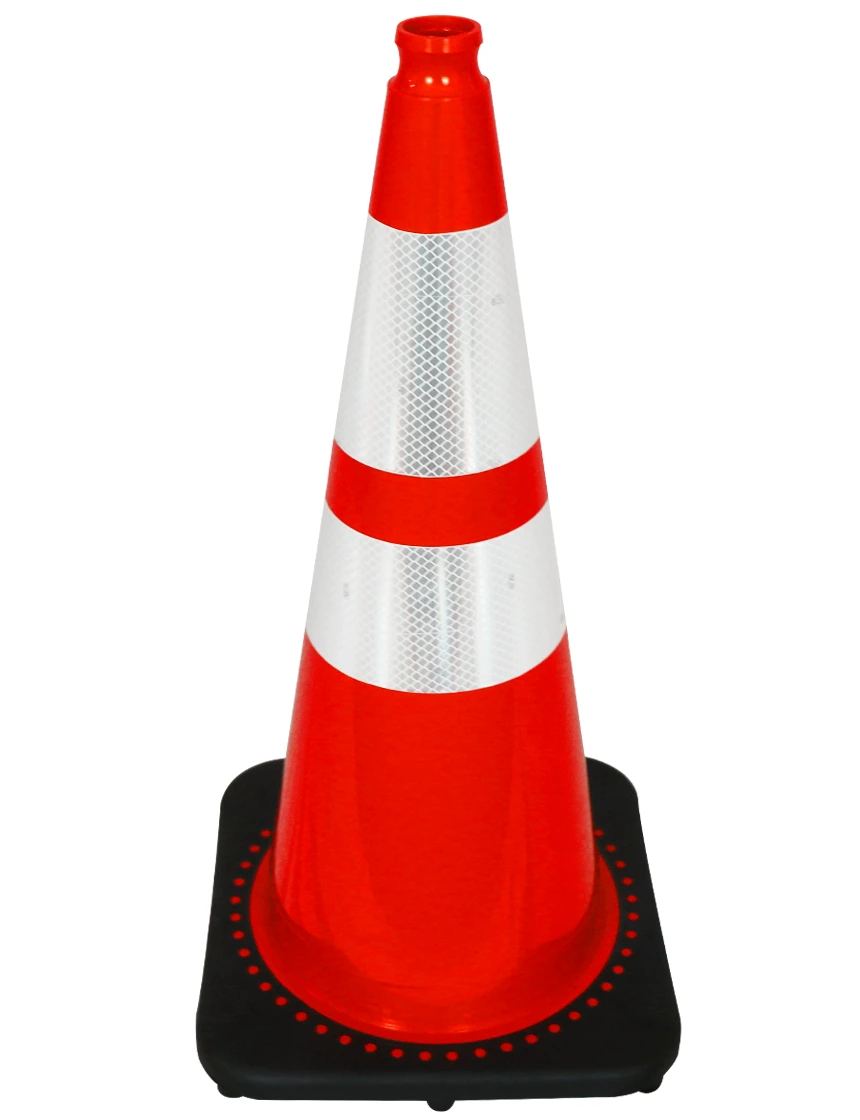28-Inch vs. 36-Inch Traffic Cones: When to Use Each
A comprehensive guide from TrafficSafetyStore.com to selecting traffic cones based on MUTCD guidelines, speed limits, and environmental factors.
Introduction to Traffic Cone Selection
Traffic cones are essential for ensuring safety in work zones, construction sites, and traffic management scenarios. Choosing the right cone size—28-inch or 36-inch—depends on factors like speed limits, visibility needs, and environmental conditions. At TrafficSafetyStore.com, we offer a wide range of MUTCD-compliant traffic cones to meet your safety needs. This guide explores the differences between these cone sizes, aligns with the Manual on Uniform Traffic Control Devices (MUTCD) standards, and provides practical tips for effective deployment.28-Inch Traffic Cones
Ideal for: Roadways with speed limits up to 45 mph, such as urban streets, residential areas, and low-to-moderate traffic zones. Common Uses:- Urban street maintenance (e.g., pothole repairs, utility work).
- Parking lot management and event traffic control.
- Local road construction or short-term work zones.
- Pedestrian safety zones near schools or community centers.
36-Inch Traffic Cones
Ideal for: High-speed roadways exceeding 45 mph, including highways, interstates, and major arterial roads. Common Uses:- Highway construction and maintenance (e.g., lane closures, bridge repairs).
- Freeway work zones requiring long-term setups.
- High-visibility zones near sharp curves or intersections.
- Emergency response scenarios on major roads.
MUTCD Reflective Collar Requirements
The Manual on Uniform Traffic Control Devices (MUTCD) provides standardized guidelines to ensure traffic cones are visible and effective, particularly in low-visibility conditions. For nighttime use, the MUTCD specifies:- Top Reflective Band: Must be 6 inches wide and positioned 3 to 4 inches from the top of the cone.
- Lower Reflective Band: Must be 4 inches wide and placed approximately 2 inches below the top band.
- Material: Reflective bands must be made of high-intensity retroreflective sheeting to ensure visibility under headlights.
Additional Factors to Consider
Beyond size and MUTCD guidelines, several practical factors influence the choice of traffic cones:- Stability: Taller 36-inch cones are inherently more resistant to tipping due to their height and wider bases. In windy or high-traffic areas, consider cones with heavier weighted bases for added stability.
- Material: Most cones are made from durable PVC or rubber, designed to withstand UV exposure, extreme temperatures, and impacts. Rubber cones are heavier and more stable but costlier than PVC.
- Base Weight and Design: Heavier bases (e.g., 10-12 lbs for 36-inch cones) are critical in high-speed or windy conditions.
- Storage and Transport: 28-inch cones are easier to stack and transport, making them ideal for mobile crews. 36-inch cones require more space but are justified for higher-risk zones.
Quick Comparison: 28-Inch traffic cones vs. 36-Inch traffic cones
| Feature | 28-Inch Traffic Cones | 36-Inch Traffic Cones |
|---|---|---|
| Speed Limit | Up to 45 mph | Over 45 mph |
| Common Uses | Urban streets, parking lots, local roads | Highways, interstates, major construction |
| Visibility | Good for daytime; reflective collars for night | Excellent due to height; collars mandatory at night |
| Stability | Moderate; needs heavier bases in wind | High; resists wind and traffic displacement |
| Portability | Lightweight, easy to transport | Bulkier, less portable |
| Cost | Slightly Lower | Slightly Higher |
Summary of Guidelines
- 28-inch traffic cones: Best for low-to-moderate speed zones (up to 45 mph), such as urban streets or parking lots. Use reflective collars for nighttime visibility and ensure stable bases in windy conditions.
- 36-inch traffic cones: Essential for high-speed roads (over 45 mph), including highways and major construction zones. Their height and stability make them ideal for high-visibility needs, with reflective collars mandatory at night.
Frequently Asked Questions
- Can 28-inch cones be used on highways?
- Generally, no. MUTCD recommends 36-inch traffic cones for highways due to their visibility and stability in high-speed environments. Check local regulations for exceptions.
- Are there alternatives to traffic cones?
- Yes, devices like Drums (barrels), delineators, or temporary barriers may be used in certain scenarios, but cones are preferred for their portability and versatility. Explore alternatives at TrafficSafetyStore.com.
Stay Safe. Stay Compliant. Choose Traffic Safety Store.

Orange 36" 10.0 Lb. Traffic Cone with Black Base
- 14" x 14" base
- Approx. 10.0 lbs. each
- Two 'recesses' molded into cone to protect reflective collars when stacked
Quick Facts:
- 36" tall, 14"x14" base, Bright Orange
- 10 lbs weight
- Safety Standards - MUTCD; NCHRP-350 crashworthy approval
- Free Shipping on orders of 385 cones or more
- call for details 800-429-9030

Orange 28" 7.0 Lb. Traffic Cone with Black Base
- 14" x 14" base
- Approx. 7.0 lbs. each
Quick Facts:
- 28" tall, 14"x14" base
- 7 lbs weight
- JBC Part No. RS70032CT3M64
- Safety Standards - MUTCD; NCHRP-350 crashworthy approval
- Free Shipping on orders of 465 cones or more
- call for details 800-429-9030

